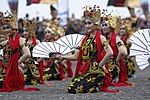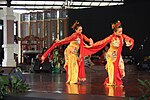Payung dance
 This dance symbolizes the appreciation of love which consists of an even number of dancers. This dance is behave by playing an umbrella as the main instrument. | |
| Origin | Indonesia |
|---|---|
| Payung dance |
|---|
|
| Burma |
| Cambodia |
|
| Indonesia |
|
| Laos |
|
| Malaysia |
| Philippines |
| Thailand |
| Vietnam |
Payung dance (Indonesian: tari Payung; Malay: tarian Payung; Minangkabau: tari Payuang; Jawi: تاري ڤايوڠ) is a folk dance-drama tradition of Minangkabau-Malay ethnic group[1] in Sumatra, Indonesia. This dance is belong to Minangkabau version of Malay dances in Sumatra. Folk theatre such as toneel and sandiwara often performs payung dance as a part of the show.[2] Payung (umbrella) is a main instrument of this dance. Payung dance symbolized affection and relationship of young people that usually performed by three or four dancers in a performance. This dance is originated from West Sumatra, Indonesia.[3]
Payung dance is performed as a part of toneel, sandiwara, exhibition, opening of party, or wedding occasion of Minangkabau people.[4]
Etymology[]
In the Indonesian languages, payung (Indonesian)[5] or payuang (Minangkabau) means "umbrella". The dance-drama is called payung dance because it is use umbrella as main instrument to depicted protection in marital relationship.
Philosophy[]
Payung dance use payung (umbrella) and selendang (shawl) as instruments. The payung is used by men and the selendang is used by women in the dance. The payung is symbolized as protection for men which is the main pillar in the family. The male dancer will protect the female dancer's head. Meanwhile, the selendang is used by female dancers. The selendang is a symbol of the sacred bond of love of the couple. In addition, this shawl also means a woman's loyalty and readiness to foster household with husband. This philosophy could be seen from the selendang that the female dancer attaches to the male dancer.[6]
Similar dances[]
Payung dance is performed by Peranakan communities in Malaysia.[7] Payung dance originated in China and was brought to Malaysia by Chinese diaspora living in the country. This dance evolved with local elements to form a popular type of Peranakan dance.[8]
See also[]
References[]
- ^ Syafrayuda, Diah Rosari. "Eksistensi Tari Payung sebagai Tari Melayu Minangkabau di Sumatera Barat". 17. Retrieved 2 November 2020. Cite journal requires
|journal=(help) - ^ "Tari Payung – Sejarah, Makna, Gerakan, Properti, Pola Lantai & Keunikan". rimbakita. Retrieved 2 November 2020.
- ^ "Tari Payung dari Sumatera Barat - Bobo". bobo.grid.id (in Indonesian). Retrieved 2020-09-18.
- ^ "PAYUNG, SENI TARI". encyclopedia.jakarta-tourism.go.id. Retrieved 2020-09-18.
- ^ "Payung". Kamus Besar Bahasa Indonesia (in Indonesian).
/pa·yung/ n alat pelindung badan supaya tidak terkena panas matahari atau hujan, biasanya dibuat dari kain atau kertas diberi tangkai dan dapat dilipat-lipat, dan ada juga yang dipakai sebagai tanda kebesaran (seperti -- bawat, -- ubur-ubur, -- iram-iram)
- ^ "Get to know the Umbrella Dance from West Sumatra". EGINDO.co (in Indonesian). 2020-08-25. Retrieved 2020-09-18.
- ^ "Tarian Chetti". Pemetaan Budaya. Retrieved 10 November 2020.
- ^ "Tarian Payung". JKKN. Retrieved 10 November 2020.
- Malay dances
- Malay culture
- Malaysian culture
- Dance in Indonesia
- Dances of Sumatra
- Minangkabau dance
- Theatre in Indonesia
- Traditional drama and theatre of Indonesia






